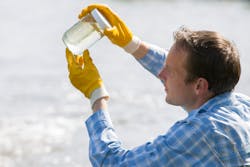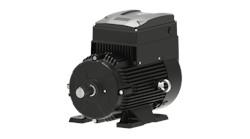Monitoring for microbiological contaminants: Bacteria, parasites and viruses
Microbiologically safe drinking water is essential in protecting public health. Microbiological contaminants can cause illness immediately and death in some cases. Microbiological contaminants are made up of bacteria, parasites and viruses. The use of disinfectants such as chlorine have significantly reduced the risk of waterborne disease, but certain contaminants like Cryptosporidium are resistant to chlorine. It can get complicated because Cryptosporidium and Giardia are two common parasites found in surface water, so groundwater does not typically have problems with these parasites unless they are under the influence of surface water. Because chlorine is not effective in removing all microbiological contaminants, additional treatments can be employed such as the use chloramine, ultraviolet (UV) light and ozone.
The U.S. Environmental Protection Agency (EPA) regulates microbiological contaminants that are known pathogens —meaning they can cause disease or illness — and others that are indicator organisms. Indicator organisms follow the same pathways as pathogens, indicating the possible presence of disease-causing organisms. This article focuses on the organisms covered under the Safe Drinking Water Act (SDWA) with information on regulations, testing and health risks.
Bacteria
Coliform and E. coli bacteria are the most commonly monitored since they are indicator bacteria and their presence could mean pathogens are present. If coliforms are found, more testing should be done to see if E. coli or fecal coliforms exist. E. coli or fecal coliforms can indicate that water may be contaminated with human or animal waste. Coliform and E. coli are common in surface water, so beaches rely on quantitative results in order to warn when water conditions are unsafe for swimming. The presence of E. coli in drinking water can pose a health risk, especially for at-risk populations including the young, immune-compromised, pregnant women and the elderly.
Coliform and E. coli are commonly tested for in municipal water based upon the size of the population served, the source of the water and how vulnerable the source is to contamination. Under the total coliform rule, no more than 5 percent of samples taken can be positive in one month. Small systems that are only required to take four samples in a month can have no more than one sample be positive per month. If samples are positive for coliform, they must also be tested for E. Coli or fecal coliforms. Some tests can look for both contaminants using one method, with an extra confirmation step for E. coli. In addition to testing for E. coli., repeat samples must be collected within 24 hours and tested for coliform and E. coli. If any repeat samples are positive, additional resamples are required. Samples that are positive for coliform are considered a monthly violation and require the system to notify the state by the end of the next business day after they find out. They are required to notify the public within 30 days. If any samples are positive for E. coli. or fecal coliform, the violation must be reported to the state by the end of next business day. The public must be notified within 24 hours.
Legionella is another bacteria that is regulated under the Safe Drinking Water Act. It is regulated as a treatment technique, which means that a system must prove it follows a treatment procedure to control Legionella in the water. Legionella bacteria is not a coliform bacteria, so coliform tests are not an indicator of the presence of Legionella. Legionella would be detected in Heterotrophic Plate Counts, also called Standard Plate Counts, which is a general test and does not specify the species of bacteria present, but gives a total number. Some tests directly check for Legionella in water, and is often used when an outbreak occurs. Legionella presents a health risk, especially to infants, the elderly and those who may have compromised immune systems. Many illnesses/diseases include drug therapies that actually weaken the immune system. A good example is psoriasis, which is a skin disease that can be treated by drugs that weaken the immune system, making the person taking the drug more susceptible to infection/illness.
Parasites
The two parasites regulated under the SDWA are Giardia and Cryptosporidium. Both are regulated for treatment techniques as required under the Surface Treatment Rule. Giardia and Cryptosporidium are typically found in animal and human waste, so they are much more likely to be prevalent in surface water or groundwater sources, which are under the influence of surface water. Five surface water treatment rules are pertinent to these parasites as well as viruses.
- The Surface Water Treatment Rule of 1989 establishes MCLGs for Legionella, Giardia lamblia and viruses at zero because of potential health risks at any level of exposure. This rule requires systems to have sufficient treatment to reduce Giardia by 99.9 percent (3-log) at minimum. This rule did not address Cryptosporidium, but did include some requirements for virus reduction and monitoring turbidity as a measurement of filtration effectiveness.
- The Interim Enhanced Treatment Rule implemented in 1998 was aimed at reducing Cryptosporidium in systems that use surface water or groundwater that is under the influence of surface water and serves a population of 10,000 or more. This rule requires 2-log removal of Cryptosporidium (99 percent) based upon using treatment techniques and monitoring turbidity. This rule also lowered the turbidity standards for systems that serve 10,000 people or more.
- In 2001 the Filter Backwash Recycling Rule was enacted, which was aimed at systems that recycle backwash water. This rule requires any returned backwash water to go through all filtration used within the system or an alternate area as designated by the state.
- The fourth regulation is the Long Term 1 Enhanced Surface Water Treatment Rule enacted in 2002, which aims to protect public health while balancing the formation of disinfection byproducts. This rule tightens up filtration requirements and requires systems to develop a profile and calculate microbial inactivation or perform monitoring on disinfection byproducts, proving levels are less than 80 percent, as required under the Stage 1 Disinfection Byproduct Rule. Under this rule, any system that is considering a change in disinfection must consult with the state for approval.
- The fifth regulation is the Long Term 2 Enhanced Surface Water Treatment Rule which goes further by requiring systems to monitor for Cryptosporidium monthly for two years to determine potential treatment needs. To lessen the financial burden on small systems, this rule allows for coli testing as an indicator organism, but if levels exceed specific concentrations they must monitor for Cryptosporidium. Based upon the results of the monitoring, some systems may be required to undertake additional treatment to ensure a reduction of Cryptosporidium from 99 to 99.9 percent. While Cryptosporidium and Giardia are resistant to chlorination, they are easily reduced by filtration or inactivated by UV light or ozone.
Finally, under the SDWA, enteric viruses are regulated by treatment techniques because of the number of organisms and the cost and reliability of testing. This group of viruses includes the following: polioviruses, coxsackieviruses and echoviruses. Of these viruses, three are poliovirsuses, 23 Coxsackie A viruses, six Coxsackie B viruses, 28 echoviruses and five other enteroviruses including the rotavirus and norovirus. Enteric viruses that infect the gastrointestinal tract of animals and humans are discharged into the environment from fecal contamination. These viruses present a concern in surface waters and groundwater, but are much more prevalent in surface waters. Most viruses are eliminated through the use of disinfectants including chlorine, UV and ozone. The surface treatment rules addresses the reduction of viruses through filtration and disinfection methods.
Treatment protects
At any given time, untreated water can contain some level of bacteria, parasite or viruses, and this includes well water. While the SDWA addresses these microbiological contaminants, by requiring the application of more stringent treatment techniques, other opportunist pathogens could be present. While opportunist pathogens are generally not pathogenic, they will cause illness if the right opportunity exists. This is the why every consumer confidence report for a public water supply has a disclaimer for vulnerable populations, including those with compromised immune systems, the elderly and infants. Private wells can be at risk, so homeowners need to be aware and take appropriate treatment action to protect those in the household.
Marianne R. Metzger is a director of business development for National Testing Laboratories, Ltd. She can be reached at [email protected] or 800-458-3330.


